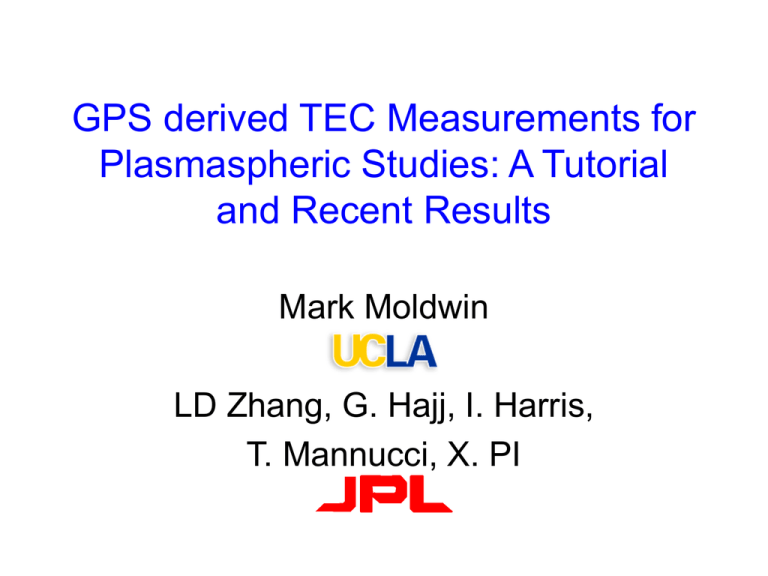GPS derived TEC Measurements for Plasmaspheric
advertisement

GPS derived TEC Measurements for Plasmaspheric Studies: A Tutorial and Recent Results Mark Moldwin LD Zhang, G. Hajj, I. Harris, T. Mannucci, X. PI GPS Orbit • • • • • 28 Satellites 55º inclination orbit 6 orbital planes 4.2 RE orbit 2 radio signals Measurements from GPS • Dual Frequency f1 and f2 -gives pseudoranges P1 and P2 and Phase information (pseudo due to offsets in clocks and ionosphere/plasmasphere) • Single freq GPS is what is used for civilian receivers to give you position (or accurate time). ... 2 1 Earth • Multiple ground stations can 6-8 GPS sats at a time • 10 second cadence • For limited areas of Earth have dense arrays and able to make global ionospheric/plasmaspheric TEC maps • Data Assimilation and Tomography possible Global TEC Maps Sparse Ground-based Coverage Relative Contribution to TEC LEO-GPS TEC Measurements • Global Coverage due to dozens of satellites with dual frequency receivers • Can be used to measure the ionospheric and plasmaspheric contribution to TEC • Data can be ingested into same algorithms developed for ground-based TEC studies LEO-GPS Technique • Dozens of current and future LEO satellites with dual-frequency GPS receivers (Topex, GPS/MET, GFO, CHAMP, SAC-C, JASON-1, GRACE, COSMIC, NPOES etc.) LEO-GPS Technique G PS 1 Elevat ion G PS 2 LEO Ionospher4e Horizon of LEO Earth Ionosphere • LEO sats have different antennas to look up fore and aft • Hundreds of occultations per day LEO-GPS comparison with Ionosonde Jakowski et al PCE-C, 2001 LEO-GPS Results 3D Global Modeling • We can go beyond TEC maps due to the large number of receivers and individual ray paths. • Can do tomography and data assimilation techniques to develop a time-dependent 3D global model of the plasma density within the GPS orbit (4.2 Re) ... 2 1 Earth • 6-10 ray paths per LEO satellite • 10 second cadence • Advantage over ground is global coverage (though less dense coverage) • Data Assimilation and Tomography possible Data Assimilation and Tomography In tomography, the ionosphere or plasmasphere is divided up into finite elements of appropriate shape. A TEC measurement, j, is related to the density in each element via the equation TECj N n(r )d n h i ij i 1 (1) where the integral is along the line-of-sight, and n(r) is the electron density at a point r along the ray path. The integral is discretized and written as the sum over all volume elements (or “voxels”), with ni corresponding to the average electron density at voxel i, and hij corresponding to the length of ray j in voxel i. Equation (1) can be written in matrix form as (2) TEC Hxe n where TEC is a vector containing the individual measurement values, x is a vector containing the unknown state parameters (electron density in a voxel), H is an “observational” matrix geometrically relating the measurements to the state, and e and n are the measurement and “representativeness” noises respectively. The latter reflects error incurred by the discretization process. Data Assimilation Equation (2) is ill-posed due to wide and irregular spacing. Data Assimilation combines a priori knowledge of the plasmasphere state at a given time, it’s a priori covariance matrix with new observations. Global Assimilative Ionospheric Model (GAIM) [Hajj et al. 2000] starts with a model and iterates until the difference between the model and all observables is minimized. Solution not unique - but with a large number of observations with good spatial coverage (and a good starting model - either empirical or physics-based) can converge to a robust solution. Kalman Filter * * Powerful Way of Assimilating Data into a TimeDependent, Physics-Based Model. Performs a Recursive least-Squares Inversion of all Data Types for Ne Using the Physics-Based Model as a Constraint. * It has the least Expected Error Given the Measurements, Model, and Error Statistics. GAIM's Approach GAIM uses a Physis-Based Ionosphere-Plasmasphere Model as a Basis for Assimilating a Diverse Set of RealTime (or Near Real-Time) Measurements. GAIM will Provide Both Specifications and Forecasts on a Global, Regional, or Local Grid. UCLA-JPL Approach • Combine LEO-GPS TEC measurements with ULF mass density observations and IMAGE EUV data • IMAGE EUV gives us plasmapause location and dynamics • Create a global 3D mass and number density model Webb and Essex Hardware Bias Conclusions • LEO-GPS possible new data source for near-real time monitoring of plasmaspheric density. • Expands ground-based TEC measurements. • Coupled with ULF techniques and IMAGE EUV the most complete sampling (in time, space, and plasma parameter space) to date. • Potential for first time dependent global model of inner magnetospheric density.











